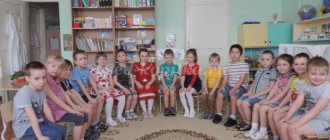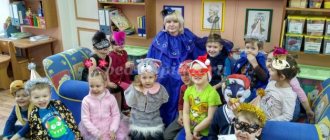Summary of music lessons in the middle group
MUSICAL CLASS IN A MIDDLE GROUP on the theme “MATRYOSHKA CAME TO VISIT US”
OBJECTIVES : EDUCATIONAL.
Continue to develop an interest in music and a desire to listen to it. Enrich children's musical experiences. Induce emotional responsiveness when perceiving musical works. Develop expressive singing skills, sing expressively, conveying the character of the song. Develop rhythmic movement skills in accordance with the lyrics of the song. DEVELOPMENTAL. Consolidate knowledge about genres in music (song, dance, march). To develop in children an interest in music and a desire to listen to it. Develop an ear for timbre, purity of intonation, hear the musical introduction and start singing the song after it. Develop the ability to stage a song, develop puppeteering skills. EDUCATIONAL. To develop the culture of listening to music (not to interfere with others listening to a piece to the end). Cultivate politeness in dealing with each other. REPERTOIRE: “Oh, you birch” Russian folk melody, music. didactic game “Recognize by voice” for the development of timbre perception. Song “Rain” music by M. Partskhaladze. dance with nesting dolls music and lyrics by N. Karavaeva MATERIAL AND ATTRIBUTES: Three flat houses of different colors, One large nesting doll, small wooden nesting dolls according to the number of children, mittens - nesting dolls according to the number of children. Disc with a recording of the song “Rain” PREVIOUS WORK, Children are familiar with genres (song, dance, march), games for the development of rhythmic and timbre hearing have been learned, children can perform movements with objects; began to introduce children to staging a song, mastering facial expressions, gestures, and the initial stage of puppeteering. PROGRESS OF THE CLASS. The music director comes to the children's group and tells them that nesting dolls have come to visit the children, they invite the children to play with them. Children enter the music room to the music and stop near the prepared chairs. The teacher draws the children's attention to the nearest house - Mus. ru-l - “A big nesting doll lives in this house, but it will come out to you if you complete the task correctly, what kind of music is this that you will now hear, and what can you do with this music? The Russian folk melody “Oh, you birch” sounds (defining the genre of music and its character). Musical director: “What is the nature of this music? The children answer - cheerful, loud, fast, Musical director: “What can we do to this music?” Children - dance. Musical director: “That’s right, dancing means dancing - cheerful, mischievous, rhythmic. The teacher places a large matryoshka doll in front of the house. Music ru-l: “Guys, let’s play the game “Recognize by Voice.” Let’s show the nesting doll how we can play. Who is our bravest? Come out." The game “Recognize by Voice” is being played to develop timbre perception. During the game, the musical director praises those children who sing the child’s name correctly. Music hand: We showed the nesting doll how we can play, and how can we sing songs? Children - yes! Music hand: I really like the way you sing the song “Rain,” shall we sing it for the matryoshka doll? Children sing the song “Rain” by muses. M. Partskhaladze. The big matryoshka praises the children and sends them to the next house, in which the nesting dolls also live. The children go to the next house. Musical director: “Little wooden nesting dolls live in this beautiful house, do you want to play with them? Children - yes! We invite the children to take a matryoshka doll and divide the children into two groups. Musical director: “Now we’ll see whose matryoshka dolls dance better for girls or boys? Music The hand sets the rhythm for the boys, and the teacher sets the rhythm for the girls. A musical and didactic game “Play Like Me” is conducted to develop rhythmic perception and musical memory. Music The leader evaluates the children's game and offers to place nesting dolls near their house. Musical director: “I invite you, guys, to another house, where nesting dolls also live and they are waiting for you. The children approach the last house. Music hand: “Look, guys, what kind of nesting dolls are waiting for you here.”, (takes out mittens - nesting dolls from the house. - “These nesting dolls want to dance with you.” Educator - “children, you are already familiar with these nesting dolls, we even drew them , Musical instructor: “And today in class we will dance with them, look how we hold the matryoshka doll (showing), look how it will dance on her palm (showing), how the matryoshka waves a handkerchief (showing).” We distribute dolls to the children, we help put it on their hand and offer to make a big circle. The children perform “Dance with Matryoshkas" music by N. Karavaeva. The musical director notes those children who are already good at holding a nesting doll on their hand and notes those children who still need to practice, Music leader - "Children, did you like the nesting dolls? Today you will take them to your group, to your music corner, I really want you to make friends with the nesting dolls (the children say goodbye and leave the hall). FUNNY ARTRYOSHKA.
EDUCATIONAL OBJECTIVES.
Tell children about the organ grinder and organ grinders. Introduce the sound of a toy barrel organ. Develop the ability to have a conversation about music. Develop the concept that a play has its own musical story, which begins with the first bars and ends with the last chord. DEVELOPMENTAL. To develop children's ability to maintain attention throughout the sound of the entire play. Learn the techniques of correct sound production. Learn to play a melody on a metallophone using a triad. To strengthen children's skills in playing together, to develop modal and timbre hearing, a sense of rhythm, and the timbre of various musical instruments. EDUCATIONAL. To develop the culture of listening to music. Cultivate politeness in dealing with each other when choosing musical instruments. REPERTOIRE. Valeological song - chant "Good morning" "Organ Grinder" by P. Tchaikovsky, "Organ Grinder" by D. Shostakovich, Illustrations by artists about organ grinders MATERIAL AND ATTRIBUTES: Portrait of the composer P. Tchaikovsky, musical instruments - metallophones - 5-6 pieces, sticks -10- 12 pieces, 5-6 bells. PREVIOUS WORK. In classes and in groups, we learned to perform familiar chants and individual parts of the play “Hurdy Organ” in small groups and individually, adhere to the general tempo, and simultaneously begin and end the game. PROGRESS OF THE CLASS. Children enter the hall to the music, the teacher offers to say hello with a chant song “Good morning”, then the children sit on the prepared chairs. The music director shows the children a toy barrel organ, how it sounds, then asks: “What fairy tale is written about a barrel organ?” We all remember “Pinocchio” and Papa Carlo together. Next there is a short conversation about the organ grinder. Musical director: Children, what do you think, who is an organ grinder? (children's statements) - Music. ru-l: “An organ grinder is a very poor man who has nothing but an organ grinder. An organ grinder is an ancient mechanical musical instrument that plays a melody when the organ grinder turns the handle. They earned their living by roaming the yards and streets. Now we will look at paintings by artists that depict organ grinders with their instrument - a barrel organ.” When viewing, I give explanations to the pictures: What does the organ grinder look like, what animals help the organ grinder - a monkey, a dog, what kind of music can sound from the organ grinder. Musical director: “We have looked at several films, and now we will listen to the music of P. Tchaikovsky (excerpt) “The Organ Grinder.” I encourage the children to try to guess what this music is talking about. Children can share their guesses after listening. Musical director: “A hurdy-gurdy is not a piano, but a mechanical box in which metal parts move to create a song. The hurdy-gurdy can play one or two very simple melodies. That's why the same song comes out of the barrel organ all the time. Today in class we will try to play the melody of a barrel organ. We have prepared musical instruments for you - metallophones, sticks and bells. Well? Are we turning into musicians? (children's answer). Together with the teacher, we seat the children in groups - children with metallophones, children with sticks, children with bells. First we play all the games separately, and only then all together. At the end of the lesson, I evaluate our orchestra and ask the children whether they liked being musicians. (children’s answer) Musical teacher - “At the next lesson we will try to play other musical instruments. The children leave the hall at a calm pace.
We recommend watching:
Summary of an open music lesson in the senior group Summary of educational activities in music in the middle group “Birds in the Spring” Musical entertainment in the middle group of a preschool educational institution. Scenario Summary of GCD in the middle group on the topic: Funny clowns
Similar articles:
Summary of a thematic music lesson in the senior group “Music Toy Store”
Middle group. Junior preschool age. Children 4 - 5 years old
Summary of a lesson on listening to music in the middle group “Acquaintance with the works of P. I. Tchaikovsky” Note on listening to music in the middle group Purpose: To introduce children to the work of P. I. Tchaikovsky using the example of his play from the cycle “Children’s Album” “March of the Wooden Soldiers” " Objectives: Teach children to feel the character and mood a musical piece Teach children to imagine...
Photo report on the lesson in the middle group “Journey to a Musical Country”
November 19 in the group “Kapitoshki”
A “Round Table”
was opened for parents , where
the music director and teachers showed the musical lesson “Journey to
a Musical Land ” .
The goal was to develop children's creative abilities based on musical and playful creativity...
Development of an introductory lesson on music education (middle group)
Development of an introductory music lesson
(middle group)
Author: Eremenko Svetlana Valerievna,
music director of MBDOU "Kindergarten No. 6"
Kalachinsk, Omsk region
LESSON No. 1
, GAME, “Acquaintance”
Program objectives: get to know children, arouse their interest in musical activities, a desire to listen to music, play musical instruments, attract attention to musical exercises, perform movements to music.
Repertoire:
“March” by I. Dunaevsky
“One, two, three, hello - speak!” (https://mp3cc.biz/m/68815-privetstvie/83488563-raz-dva-tri-zdravstvuj-govori/)
“Radiant sun, hello” by T. Nagibina
"Rain, rain, don't rush"
Materials: toy crow (glove doll), metallophones, sticks, massage balls, audio materials.
Progress of the lesson:
Entrance
children to the music room (accompanied by “March” by I. Dunaevsky).
Greetings. Musical-rhythmic exercise
“One, two, three, hello, say!”
The appearance of Karlushi (crow) - Hello!
Carlusha meets the children.
Breathing exercise is a game.
Children stand in a circle. Carlusha sits on the one who sings:
-Carlusha, Carlusha,
Listen to me:
Ah-ah-ah! (La...)
MR: Guys, we played and said hello to Carlos. Who is she? (bird, representative of wildlife). What else can we say hello to?
Musical exercise + Finger gymnastics.
Chant “Radiant Sun”:
- listening;
— discussion (what the song is about, what you can say hello to);
— pronouncing words using finger exercises and movements;
- singing a song to music.
Carlusha asks what instrument is on the recording.
Introduction to a musical instrument
- metallophone.
MR shows it, the children touch the plates, find out that they are made of metal, hence its name - metallophone
.
Von
is the name of the mysterious, invisible creature that lives in the instrument. He is invisible, but you can hear him!
MR plays the song “Radiant Sun”, the children sing along.
A game
"It's Fon!" The MP behind the screen makes sounds using sticks, etc. If a metallophone sounds, the children shout “This is Fon!” or clap.
MR and the children discuss what the sounds of a glockenspiel are like (drops, pieces of ice, rain...)
Exercise in singing and playing music
MR sings the song “Rain, rain, don’t rush”, accompanying with a metallophone on the last words in the line (drip-drip-drip), encourages children to play the metallophones. You can first clap the drawing with your hands, tap on sticks, stamp, etc.
After singing the song, MR asks the children to improvise, to “play” heavy rain, light, quiet rain (sunshine – no play).






